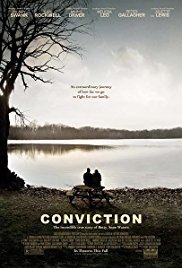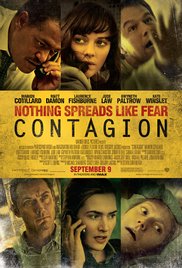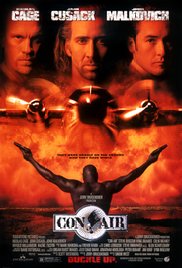 Nothing about “Conviction” makes sense. For starters, how did this routine Lifetime Movie of the Week (with excessive profanity) get the green light to become a major motion picture? And once that happened, how did Fox Searchlight, the best and most tasteful live action studio working today, become its home? Lastly, how did they convince Hilary Swank and Sam Rockwell, good actors both, that it was worth doing? Was it the faint whiff of Oscar bait? You’d think that Swank knows what that smells like, and this movie isn’t it.
Nothing about “Conviction” makes sense. For starters, how did this routine Lifetime Movie of the Week (with excessive profanity) get the green light to become a major motion picture? And once that happened, how did Fox Searchlight, the best and most tasteful live action studio working today, become its home? Lastly, how did they convince Hilary Swank and Sam Rockwell, good actors both, that it was worth doing? Was it the faint whiff of Oscar bait? You’d think that Swank knows what that smells like, and this movie isn’t it.
Set in rural Massachusetts in the year 1980, Betty Anne Walters (Swank) and her hot-tempered older brother Kenny (Rockwell) have essentially survived their childhood after shuffling through foster homes. When a resident is found brutally murdered, Kenny is brought in for questioning but released. Three years later, he’s arrested for the crime, convicted and ultimately sentenced to life in prison. Betty Anne is so convinced of her brother’s innocence that she goes to law school part time in order to represent her brother and earn his freedom. Her family doesn’t share her enthusiasm, though, and her classmates and professors are unsympathetic to her familial responsibilities. But Betty Anne soldiers on, and gains a valuable ally in the process: Barry Scheck (Peter Gallagher), attorney from the Innocence Project, and together they fight the system tooth and nail.
It’s a great story, really – it’s the execution that doesn’t work. Before Betty Anne could get into law school, she had to earn her GED (remember, bad childhood), then a bachelor’s degree, then a masters, and then finally pass the bar. The movie thankfully doesn’t show us all of this, but it sure feels like they do, perhaps due to the stock characters and plot developments that populate Pamela Gray’s script. The snotty law school students, the dirty cops, the two children (one sullen, one supportive), the disapproving ex-husband-to-be, the big break, the political red tape – it s difficult to get emotionally involved, because the audience knows exactly when she’ll fly and when she’ll be tripped.
The movie’s biggest roadblock is the trial itself, which any casual “Law & Order” viewer could eviscerate on cross-examination even if they were watching the proceedings on a bar TV with the sound turned off. The prosecuting attorney makes much of the blood type found on the victim – it’s type O. Kenny has type O, therefore he must be the killer, even though over 40% of the population has the same blood type. The other evidence is almost entirely eyewitness testimony, and we never see Kenny take the stand to refute any of the claims. The lopsidedness in the presentation of Kenny’s case is so egregious that it borders on parody. Swank, Rockwell and Minnie Driver, who plays Betty Anne’s law school buddy Abra, are all perfectly good here (and Juliette Lewis steals the movie in her most white trash role to date), but the material doesn’t deserve them.
One wonders if the Oscar buzz following movies like “Conviction” is simply the ripple effect of the Academy Awards bumping the number of Best Picture nominees from five to ten. Allow us to burst that bubble; this is not an Oscar-caliber movie. It’s not even an Emmy-caliber TV movie. All concerned have done better, and will do better again. Move along, people. Nothing to see here.
 (2.5 / 5)
(2.5 / 5)





 (3.5 / 5)
(3.5 / 5)



 (1 / 5)
(1 / 5)

 (4 / 5)
(4 / 5)
 (3 / 5)
(3 / 5)


 (1.5 / 5)
(1.5 / 5)
